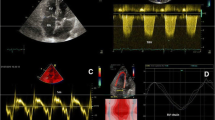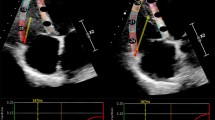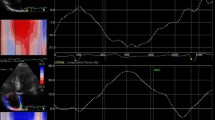Abstract
Several studies have evidenced high prevalence of myocardial systolic and diastolic dysfunction among patients with systemic sclerosis (SSc). Exercise echocardiography has shown a diagnostic and prognostic role in identifying early left ventricular (LV) dysfunction in several myocardial pathological settings. The aim of our study was to evaluate early signs of LV impairment under exercise and their correlation to patient’s exercise tolerance. Forty-five patients (age 60.4 ± 10.3 years) with SSc and 20 age and sex comparable controls were enrolled in the study. All patients underwent clinical evaluation, 2D echocardiography associated with Tissue Doppler and speckle tracking to evaluate LV deformation indexes, and an exercise echocardiography to evaluate left ventricle contractile reserve (LVCR) and exercise pulmonary pressures. Finally, a 6-minute walking test (6MWT) to evaluate exercise tolerance was also performed. Compared to controls, SSc patients showed an impaired diastolic function (E/E′ 10.9 ± 3.7 vs 8.36 ± 2.01; p < 0.01) associated with larger left atrial dimensions (LAVI 28.4 ± 8.7 vs 19.3 ± 4.6 mL/m2; p < 0.01). During exercise echocardiography, a reduced global longitudinal strain at peak exercise (S-GLS) was highlighted compared to controls (15.7 ± 3.6 vs 18.2 ± 2.2; p = 0.001). A S-GLS cutoff <18 %, identified by ROC analysis, identified SSc patients with a reduced diastolic function, exercise tolerance at the 6MWT and higher pulmonary pressures. Our data show that in SSc patients a reduced LVCR characterizes the patients with a more extensive cardiovascular impairment in terms of LV diastolic function, pulmonary pressures and exercise tolerance. These data underline the importance of exercise echocardiography for the preclinical screening of the LV impairment in this population.



Similar content being viewed by others
References
van den Hoogen F, Khanna D, Fransen J et al (2013) 2013 classification criteria for systemic sclerosis: an American College of Rheumatology/European League against Rheumatism collaborative initiative. Arthritis Rheum 65:2737–2747. doi:10.1002/art.38098
Barnes J, Mayes MD (2012) Epidemiology of systemic sclerosis: incidence, prevalence, survival, risk factors, malignancy, and environmental triggers. Curr Opin Rheumatol 24:165–170. doi:10.1097/BOR.0b013e32834ff2e8
Tyndall AJ, Bannert B, Vonk M et al (2010) Causes and risk factors for death in systemic sclerosis: a study from the EULAR Scleroderma Trials and Research (EUSTAR) database. Ann Rheum Dis 69:1809–1815. doi:10.1136/ard.2009.114264
Hachulla E, Carpentier P, Gressin V et al (2009) Risk factors for death and the 3-year survival of patients with systemic sclerosis: the French ItinérAIR-Sclérodermie study. Rheumatology (Oxford) 48:304–308. doi:10.1093/rheumatology/ken488
Bulkley BH, Ridolfi RL, Salyer WR, Hutchins GM (1976) Myocardial lesions of progressive systemic sclerosis. A cause of cardiac dysfunction. Circulation 53:483–490
Desai CS, Lee DC, Shah SJ (2011) Systemic sclerosis and the heart: current diagnosis and management. Curr Opin Rheumatol 23:545–554. doi:10.1097/BOR.0b013e32834b8975
Mizuno R, Fujimoto S, Saito Y, Nakamura S (2010) Cardiac Raynaud’s phenomenon induced by cold provocation as a predictor of long-term left ventricular dysfunction and remodelling in systemic sclerosis: 7-year follow-up study. Eur J Heart Fail 12:268–275. doi:10.1093/eurjhf/hfp198
Blessberger H, Binder T (2010) NON-invasive imaging: two dimensional speckle tracking echocardiography: basic principles. Heart 96:716–722. doi:10.1136/hrt.2007.141002
Yiu KH, Schouffoer AA, Marsan NA et al (2011) Left ventricular dysfunction assessed by speckle-tracking strain analysis in patients with systemic sclerosis: relationship to functional capacity and ventricular arrhythmias. Arthritis Rheum 63:3969–3978. doi:10.1002/art.30614
Grünig E, Janssen B, Mereles D et al (2000) Abnormal pulmonary artery pressure response in asymptomatic carriers of primary pulmonary hypertension gene. Circulation 102:1145–1150
Gargani L, Pignone A, Agoston G et al (2013) Clinical and echocardiographic correlations of exercise-induced pulmonary hypertension in systemic sclerosis: a multicenter study. Am Heart J 165:200–207. doi:10.1016/j.ahj.2012.10.020
Voilliot D, Magne J, Dulgheru R et al (2014) Determinants of exercise-induced pulmonary arterial hypertension in systemic sclerosis. Int J Cardiol 173:373–379. doi:10.1016/j.ijcard.2014.02.042
Collins N, Bastian B, Quiqueree L, Jones C, Morgan R, Reeves G (2006) Abnormal pulmonary vascular responses in patients registered with a systemic autoimmunity database: pulmonary hypertension assessment and screening evaluation using stress echocardiography (PHASE-I). Eur J Echocardiogr 7:439–446. doi:10.1016/j.euje.2005.12.002
Ha JW, Lee HC, Kang ES et al (2007) Abnormal left ventricular longitudinal functional reserve in patients with diabetes mellitus: implication for detecting subclinical myocardial dysfunction using exercise tissue Doppler echocardiography. Heart 93:1571–1576. doi:10.1136/hrt.2006.101667
Cadeddu C, Nocco S, Piano D et al (2013) Early impairment of contractility reserve in patients with insulin resistance in comparison with healthy subjects. Cardiovasc Diabetol 12:66. doi:10.1186/1475-2840-12-66
Cadeddu C, Nocco S, Deidda M, Pau F, Colonna P, Mercuro G (2013) Altered transmural contractility in postmenopausal women affected by cardiac syndrome X. J Am Soc Echocardiogr 27:208–214. doi:10.1016/j.echo.2013.09.014
Mavrogeni S, Bratis K, van Wijk K et al (2012) Myocardial perfusion-fibrosis pattern in systemic sclerosis assessed by cardiac magnetic resonance. Int J Cardiol 3:e56–e58. doi:10.1016/j.ijcard.2011.12.039
Tzelepis GE, Kelekis NL, Plastiras SC et al (2007) Pattern and distribution of myocardial fibrosis in systemic sclerosis: a delayed enhanced magnetic resonance imaging study. Arthritis Rheum 56:3827–3836. doi:10.1002/art.22971
Kahan A, Allanore Y (2006) Primary myocardial involvement in systemic sclerosis. Rheumatology (Oxford) 45(Suppl 4):14–17. doi:10.1093/rheumatology/kel312
Fernandes F, Ramires FJ, Arteaga E, Ianni BM, Bonfá ES, Mady C (2003) Cardiac remodeling in patients with systemic sclerosis with no signs or symptoms of heart failure: an endomyocardial biopsy study. J Card Fail 9:311–317. doi:10.1054/jcaf.2003.51
de Groote P, Gressin V, Hachulla E et al (2008) Evaluation of cardiac abnormalities by Doppler echocardiography in a large nationwide multicentric cohort of patients with systemic sclerosis. Ann Rheum Dis 67:31–36. doi:10.1136/ard.2006.057760
Meune C, Avouac J, Wahbi K et al (2008) Cardiac involvement in systemic sclerosis assessed by tissue-Doppler echocardiography during routine care: a controlled study of 100 consecutive patients. Arthritis Rheum 58:1803–1809. doi:10.1002/art.23463
Ciurzyński M, Bienias P, Lichodziejewska B et al (2008) Non-invasive diagnostic and functional evaluation of cardiac involvement in patients with systemic sclerosis. Clin Rheumatol 27:991–997. doi:10.1007/s10067-008-0837-9
Valentini G, Vitale DF, Giunta A et al (1996) Diastolic abnormalities in systemic sclerosis: evidence for associated defective cardiac functional reserve. Ann Rheum Dis 55:455–460
Can I, Onat AM, Aytemir K et al (2009) Detecting subclinical biventricular impairment in scleroderma patients by use of pulsed-wave tissue Doppler imaging. Tex Heart Inst J 36:31–37
Spethmann S, Dreger H, Schattke S et al (2012) Two-dimensional speckle tracking of the left ventricle in patients with systemic sclerosis for an early detection of myocardial involvement. Eur Heart J Cardiovasc Imaging 13:863–870. doi:10.1093/ehjci/jes047
Cusmà Piccione M, Zito C, Bagnato G et al (2013) Role of 2D strain in the early identification of left ventricular dysfunction and in the risk stratification of systemic sclerosis patients. Cardiovasc Ultrasound 11:6. doi:10.1186/1476-7120-11-6
Akdogan A, Kaya EB, Sahin A et al (2011) Relationship between left ventricular diastolic dysfunction and six minute walk test in patients with systemic sclerosis. Int J Rheum Dis 14:379–383. doi:10.1111/j.1756-185X.2011.01672.x
Codullo V, Caporali R, Cuomo G et al (2013) Stress Doppler echocardiography in systemic sclerosis: evidence for a role in the prediction of pulmonary hypertension. Arthritis Rheum 65:2403–2411. doi:10.1002/art.38043
D’Alto M, Ghio S, D’Andrea A et al (2011) Inappropriate exercise-induced increase in pulmonary artery pressure in patients with systemic sclerosis. Heart 97:112–117. doi:10.1136/hrt.2010.203471
Hinchcliff M, Desai CS, Varga J, Shah SJ (2012) Prevalence, prognosis, and factors associated with left ventricular diastolic dysfunction in systemic sclerosis. Clin Exp Rheumatol 30:S30–S37
Költő G, Faludi R, Aradi D et al (2014) Impact of cardiac involvement on the risk of mortality among patients with systemic sclerosis: a 5-year follow-up of a single-center cohort. Clin Rheumatol 33:197–205. doi:10.1007/s10067-013-2358-4
Conflict of interest
All authors have no conflict of interest to disclose.
Ethical standard
The study was approved by the Ethics Committee of the University Hospital, University of Cagliari. Written informed consent was obtained from all patients involved. The study was carried out in accordance with the Declaration of Helsinki.
Author information
Authors and Affiliations
Corresponding author
Rights and permissions
About this article
Cite this article
Cadeddu, C., Deidda, M., Giau, G. et al. Contractile reserve in systemic sclerosis patients as a major predictor of global cardiac impairment and exercise tolerance. Int J Cardiovasc Imaging 31, 529–536 (2015). https://doi.org/10.1007/s10554-014-0583-9
Received:
Accepted:
Published:
Issue Date:
DOI: https://doi.org/10.1007/s10554-014-0583-9




